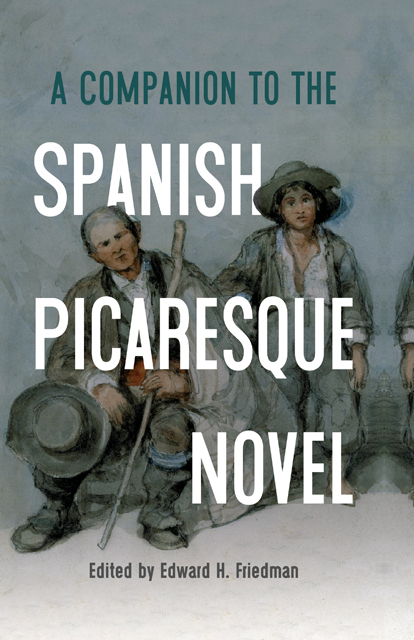Book contents
- Frontmatter
- Contents
- List of Illustrations
- List of Contributors
- Foreword
- 1 The Picaresque as a Genre
- 2 On the Picaresque and Its Origins
- 3 Francisco Delicado, La lozana andaluza
- 4 Lazarillo de Tormes
- 5 Mateo Alemán, Guzmán de Alfarache
- 6 Francisco de Quevedo, La vida del Buscón
- 7 La pícara Justina
- 8 Alonso Jerónimo de Salas Barbadillo, La hija de Celestina
- 9 Miguel de Cervantes and the Picaresque
- 10 Vicente Espinel, Marcos de Obregón
- 11 Carlos García, La desordenada codicia de los bienes agenos
- 12 Estebanillo González
- 13 Critical Approaches to the Picaresque
- 14 The Picaresque in Spanish America
- 15 Continuations: France and England
- 16 The Continuity of the Picaresque: Spain
- Bibliography
- Index
- Tamesis • Companions
2 - On the Picaresque and Its Origins
Published online by Cambridge University Press: 11 January 2023
- Frontmatter
- Contents
- List of Illustrations
- List of Contributors
- Foreword
- 1 The Picaresque as a Genre
- 2 On the Picaresque and Its Origins
- 3 Francisco Delicado, La lozana andaluza
- 4 Lazarillo de Tormes
- 5 Mateo Alemán, Guzmán de Alfarache
- 6 Francisco de Quevedo, La vida del Buscón
- 7 La pícara Justina
- 8 Alonso Jerónimo de Salas Barbadillo, La hija de Celestina
- 9 Miguel de Cervantes and the Picaresque
- 10 Vicente Espinel, Marcos de Obregón
- 11 Carlos García, La desordenada codicia de los bienes agenos
- 12 Estebanillo González
- 13 Critical Approaches to the Picaresque
- 14 The Picaresque in Spanish America
- 15 Continuations: France and England
- 16 The Continuity of the Picaresque: Spain
- Bibliography
- Index
- Tamesis • Companions
Summary
The genre known as the Spanish picaresque takes its name from its protagonist, the pícaro, a literary character that first appeared in the anonymous novel Lazarillo de Tormes (1554). Despite its brevity, the seemingly simple little text, narrated in the first person by a lower-class good-for-nothing, profoundly altered the course of Spanish literary history by generating a new kind of prose fiction. Although the term pícaro itself was applied only to Mateo Alemán’s Guzmán de Alfarache (1599, 1604) – the word never appears in the Lazarillo, whereas Guzmán was actually referred to as the Libro del pícaro – the relationship between the two novels was clearly established by their similar autobiographical structure and satirical style, which attracted an extensive readership. Lazarillo’s four extant editions, published the same year in four important trade centers (Alcalá de Henares, Burgos, Medina del Campo, and Antwerp), had already proven its popularity; even more remarkably, the first part of Guzmán saw 24 editions within six years (Howard Mancing, “Guzmán de Alfarache and After” 40).
When constructing the literary canon, nineteenth-century scholars endeavored to codify the picaresque genre’s salient characteristics, notably those most evident in the three early modern texts that quickly assumed top ranking: Lazarillo de Tormes, Guzmán de Alfarache, and Francisco de Quevedo’s El Buscón (1604; first published in 1626). This new genre radically challenged the chivalric and sentimental novels then in vogue with its vivid realism, enhanced by its first-person narration, an ironic reflection on morality, stress on material existence, and social criticism. Its distinctive style thus differed fundamentally from previous Spanish literary fiction, whose omniscient accounts of the amorous and military exploits of aristocratic heroes stressed their dualistic morality and conservative ideology. In contrast, the picaresque genre’s first-person narrative imposed a singular perspective from the pícaro’s lower-class point of view, while its ironic tenor raised immediate doubts as to the narrator-protagonist’s reliability (Francisco Rico, The Spanish Picaresque).
Yet these features have had a long literary history, appearing in various kinds of writings. While modern studies of genre theory have reconceptualized prose narratives into more specific categories, it is well to remember that, short of religious texts, early modern readers were rarely concerned with such distinctions; indeed, in Spain, as Lía Schwartz explains in her study of satire, theory was developed post-factum (Lía Schwartz Lerner, “Golden Age” 282).
- Type
- Chapter
- Information
- A Companion to the Spanish Picaresque Novel , pp. 7 - 19Publisher: Boydell & BrewerPrint publication year: 2022



